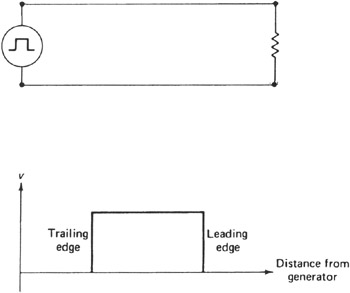Schaum's Outline of Theory and Problems of Electronic Communication, Second Edition

Electromagnetic waves travel in free space at 3 10 8 meters/s or 186 000 miles/s. In other than free space, electromagnetic waves travel a bit slower; however, as a first approximation the speed in free space can be assumed to be the speed on a transmission line. If a signal varies so rapidly or the line is so long that before the leading edge of the signal reaches the end of the transmission line the incoming signal undergoes an appreciable change, we must consider how the transmission line affects the signal.
Consider a pulse launched on a 100-meter transmission line. The pulse is to be of such short duration that the leading edge does not arrive at the load end of the line before the trailing edge of the pulse has left the generator. The amount of time for the signal to travel the length of the transmission line can be calculated as follows:
If the pulse width is less than 333 ns in duration, the voltage at the generator will have returned to zero before the leading edge of the pulse arrives at the load. Figure 5-1 describes this situation.

Now consider a sine wave traveling on a transmission line whose length is appreciable compared to the wavelength of the sine wave. The wavelength of the sine wave is defined as the distance traveled by an electromagnetic signal during...
